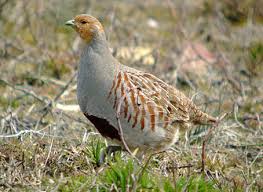The (grey) partridge (Perdix perdix) is a native steppe dweller and culture follower, a field bird from the family of pheasants (Phasianidae).
 An adult partridge is about 30 centimeters tall, weighs between 300 and 500 grams, and has rounded small wings.
An adult partridge is about 30 centimeters tall, weighs between 300 and 500 grams, and has rounded small wings.
The legs are gray, brown head and throat. Males have a dark horseshoe-shaped belly spot, the hens a smaller one and the chicks none.
The age of a wild partridge is around 2 to 5 years.
Partridges are found in meadows, fields and vacant lots with wooded banks.
Partridges live in groups, which are called covey. The call of the partridge is a clearly recognizable kir - I.
A call is (as opposed to song) the one-or two-syllable sound that serves as the communication between members of the covey.
Partridges are sedentary birds with excellent vision and hearing.
They can only fly 500 to 1,000 meter and then fall down again.
Partridges drink dew and rain drops hanging on leaves so they get a lot of pesticides by which the population has been threatened.
These animals are unlike quail, pheasants and chickens monogamous.
If both parents survive the winter, they form again a couple and retain the territory of last year. They always remain in close proximity and never lose sight of each other.
The nest is a with the legs scribbled hole, 18 cm wide and 6 cm deep.
It is made in a small always remaining dry raise, e.g. an intermediate verge, in a place with nest- and covering stuff, and low shrubs (< 2m).
The eggs are about 3.5 cm long and 2.5 cm wide, pear -shaped to oval with a weight of 13 grams. The female incubates 12-20 olive, sometimes shiny greenish eggs that are slightly smaller than that of a chicken. The male protects the nest.
After the covering from the nest the hen leaves 2-5 times a day for 25 minutes the breeding ground to find food, taking a dust bath and defecate.
When in danger the birds press themselves to the ground, or fly calling and with audible wing beats low over the ground.
Searching food as grain, seeds and insects also occurs on sight, from sunrise to sunset. The chickens eat the first few weeks only insects and small animals.
Around noon partridges take a dust bath against parasites (feather lice, fleas) and mud residue on the legs, and they lie to rest in order to promote the first digestion.
During the night partridges look up open resting place. The birds sit in groups of four to six in a tight circle, heads outwardly directed to note oncoming enemies.
Young partridges are, like quail, wrapped in grape leaves and fat and fried. Old partridges are simmered with bits of bacon and are excellent in a pot - au – feu (stew).
Animals cannot speak; if they say they can, then they are lying.
